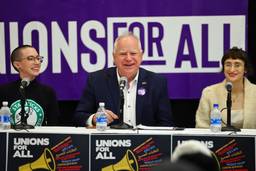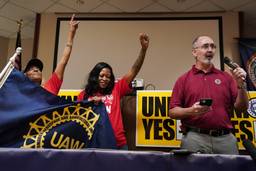The Union Members Who Voted for Trump Have to Be Organized—Not Ignored
Unions should be holding more political discussions with their members—and listening closely to their needs.
Mindy Isser
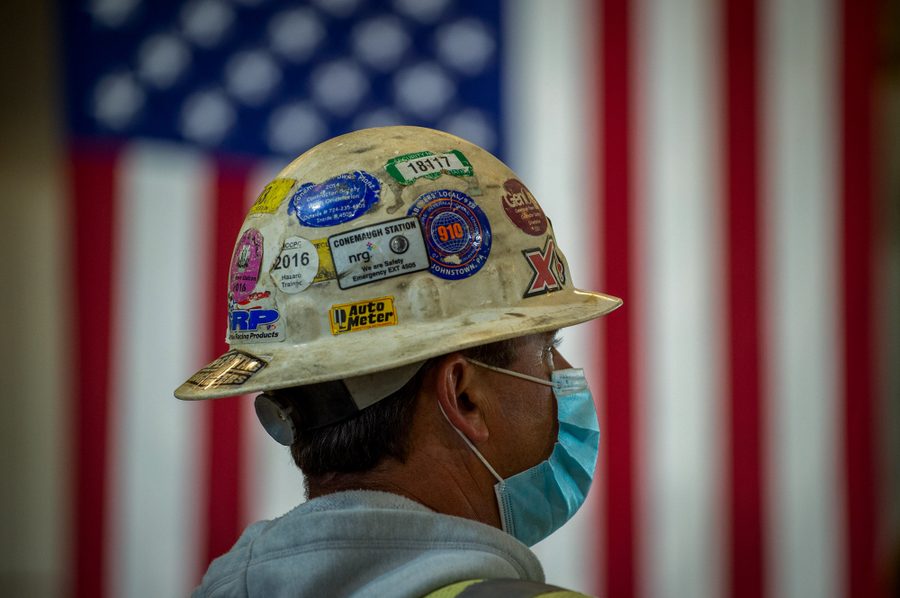
Although President Donald Trump will be leaving the White House, progressives must reckon with the fact that 74 million people — almost a third of whom came from households making under $50,000—voted for him. It is alarming that so many working-class people would vote against their class interests, but perhaps most alarming of all are the union members who were drawn in by Trumpism. Before the 2016 election, Democratic presidential candidates had long won union households by comfortable double-digit margins; but in 2016 and 2020, Trump eroded those margins. If the Left is to win progressive policies (and the next presidential election), it needs a militant labor movement. Unions, after all, are one of the only effective working-class institutions in this country that can engage workers to build power on the job and in society at large. We must understand who these union Trump voters are, why they voted for Trump, and what can be done to win them back.
Many on the Left have written off Trump supporters as a lost cause or unworthy of effort. This response is understandable, particularly for people of color and others directly harmed by Trump policies. And we should by no means court the vocal subset of Trumpists who are virulent white supremacists.
But most Americans hold a confusing mix of political beliefs that will never fit squarely within the Democratic and Republican parties. When the group Working America held in-depth conversations with more than 2,300 working-class voters in so-called battleground states in 2016 and 2017, it found that beliefs didn’t map to party lines: Voters believed in both expanding the coal industry and protecting the environment; in both universal healthcare and keeping out “freeloading” refugees; in both banning abortion and lowering healthcare costs. A 2019 poll from the Kaiser Family Foundation and Cook Political Report found that, in battleground states, 70% of respondents supported a pathway to citizenship for undocumented immigrants and yet 71% felt it was a bad idea not to detain people who crossed the border without documentation. Not every issue drives voting behavior: 70% of Americans support Medicare for All, and yet the presidential candidate championing the policy (Sen. Bernie Sanders) came up short.
If the goal of reaching out to Trump voters is to activate their progressive beliefs strongly enough to influence their voting behavior, then union Trump voters should be a promising place to start. A good union naturally ties the fate of the worker to others, a powerful counter-narrative to the rugged individualism our society (and Trump) promotes. Union members are also (theoretically) trained and experienced in fighting their bosses. Being part of a struggle against a boss means reliance on fellow workers, regardless of race and gender and other social divisions. Unions themselves, of course, need to embark on a far-reaching program for membership to put these struggles in context — one that doesn’t shy away from tough questions in fear of upsetting a (tenuous) sense of unity.
Discussions around immigration and racism, for example, are challenging in their own right but have become especially charged since Trump took office. Avoiding these topics may preserve a sense of unity in the short term but damages the long-term ability of workers to forge solid bonds of solidarity and organize to fight against racism and social programs like Medicare for All.
To understand how unions might reach the union Trump voter, we can look at how similar efforts have succeeded and failed — and get to know union Trump voters themselves.
The Trump Unionist
Tony Reitano, 49, works in maintenance at a Bridgestone plant in Iowa. He is a member of the United Steelworkers and voted for Trump in 2016 and 2020. Reitano tells In These Times, “I liked what [Trump] said about trade deals in 2016; that was a big thing for me … bringing jobs back to America.” He adds, “And this time around, [Trump] did, or tried to accomplish, all of the things he said he was going to do … like backing away from the [Trans-Pacific Partnership].” (The United Steelworkers, which endorsed Biden in 2020 and Clinton in 2016, opposes the trade deal, on the grounds that jobs would be lost.)
Trump voters often cite their concern with jobs and wages as the reason they voted for him. While most voters rank the economy as one of their most important issues, 84% of Trump voters rated the economy as “very important” in 2020, compared to Biden supporters’ 66%.
Lynne (who didn’t want her last name used for fear of social retaliation), 62, is a retired teacher and union member in the suburbs of Philadelphia. A registered Independent, Lynne voted for Obama in 2008, moved by his message of hope and change. Like Reitano, she was drawn to Trump in 2016 by his economic promises — and voted Trump again in 2020. “You can’t care about other policies if you’re worried about losing your house or if your children don’t have food or if your heat may get turned off,” Lynne tells In These Times. “Having shelter and food is everyone’s number one concern. And with Trump, we had the lowest unemployment rate in this country … for everyone, including Latinos and Blacks.”
Trump clearly understood that a strong economic message would be the key to victory, boasting about the unemployment rate on the 2020 campaign trail. But the Trump unemployment rate only decreased slightly before the pandemic, and likely because of Obama-era policies. Meanwhile, wage growth has stagnated or declined for the bottom 70% of workers since the 1970s and the Job Quality Index (a proxy for the overall health of the U.S. jobs market) fell significantly after 2006 and never recovered.
Amid this uncertainty, Trump parlayed economic concerns into his brand of racism to drive white voters. Of course, many Trump voters do not consider Trump an ardent racist. For example, Ernie Justice, 76, a retired coal miner in Kentucky, tells In These Times that “there’s not a racist drop of blood in Donald Trump.” Like Lynne, Justice also voted for Obama and later Trump. Lynne, too, says she “doesn’t really see the racism.”
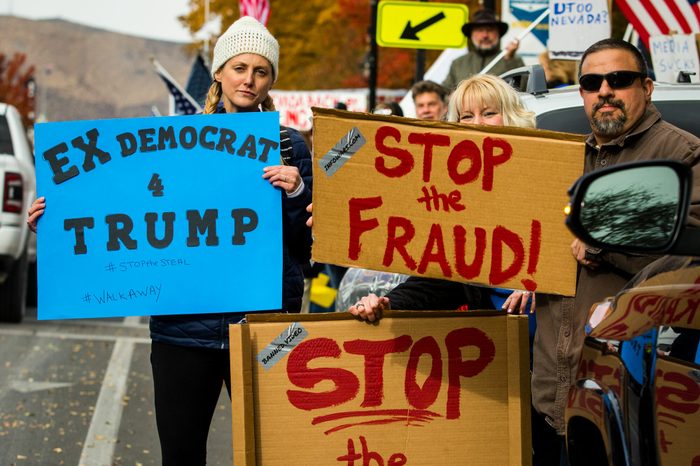
But Trump certainly associated the decline in quality of life experienced by white workers with not only the Democratic Party, but immigrants and other people of color. George Goehl, director of the national grassroots organizing network People’s Action, says “Democrats’ lack of willingness to name the enemy — runaway corporate power — just left a huge vacuum for the Right to use race and immigration.”
While Republicans authored the so-called right-to-work legislation that has undermined union organizing, Democrats are the proponents of the free trade agreements that have decreased wages and off-shored jobs. Decades of economic devastation — including loss of good union jobs in the Rust Belt, factories moving abroad and stagnant wages— opened a door for Trump to step through. Goehl says people have “clearly been punched in the gut tons of times by neoliberalism” — and Trump’s campaign capitalized on that by promising to bring back manufacturing jobs.
This landscape is difficult for both unions and the Democratic Party. While union leadership has thrown its weight behind Democrats in hopes of better organizing terrain, establishment Democrats are caught between unions and their party’s allegiance to big business. And the Democrats have a history of making labor promises they don’t keep. In 2008, Obama ran on passing the Employee Free Choice Act, which would have made the process of unionization faster and easier — but didn’t champion the bill once elected. And unions, which are no match for lobbying efforts by giant corporations like Walmart or Home Depot, couldn’t win the law alone. Repeated disappointments have led union members to lose faith in institutions they once held dear.
That loss of faith played out in the 2016 and 2020 elections. After unions spent record amounts on campaigns to defeat Trump, Hillary Clinton won union households by only 8% in 2016 (to Obama’s 18% in 2012), a small enough margin to cost her Pennsylvania, Michigan and Wisconsin (and the election). And after unions broke that 2016 record in 2020, Biden won union households by 16% (and won those three states back), but Trump won union households in Ohio by 12% (which Obama had won by 23%). Unions can spend huge amounts of money and mobilize the votes of a (declining) portion of their members, but to keep those members from slipping away, they’ll need to do much more.
A Battle of Ideas
Each of the three Trump voters who spoke with In These Times for this story mentioned jobs and the economy as big issues, but all independently shared concerns about open borders, later abortions, and the creep of socialism and communism. These issues are discussed nearly constantly on Fox News and by conservative radio personalities like Rush Limbaugh and Sean Hannity. And as trust of the media is at an almost all-time low, many Trump supporters only tune into media that reflects what they already believe — just as centrist and liberal Democrats watch CNN or MSNBC. Never mind that the U.S.-Mexico border wall was started under President Bill Clinton, later abortions are exceedingly rare and most socialist organizing is about basic rights, like healthcare and a living wage.
The constant onslaught of hateful messages from rightwing media and the war waged against the working class by the rich has led U.S. workers into a fog of confusion without an ideological beacon to help clarify and fight back. The unions that have survived have become more insular, increasingly focused on the immediate issues of their own members, taking a concessionary approach that treats bosses like coalition partners. If the Left and unions hope to make appeals to union Trump voters (and other sections of the working class), this strategy must change.
Unions need to cut through the right-wing fog of disinformation by offering educational programs of their own to explain the systemic problems causing the decline in workers’ conditions. One model, offered by People’s Action, has shown that talking with Trump supporters about systemic issues can effectively shift attitudes. Beginning in 2017, George Goehl and People’s Action embarked on a rural and small-town organizing project, focused on “deep canvassing,” to show white people how systemic racism is real and actively harming them and their communities. (Some of these people are union members, though many are not.) While many (especially nonwhite) people on the Left find it difficult to have conversations with Trump supporters (fearing abuse or just afraid of wasted energy), Goehl sees the talks as crucial. “While you are much more likely to live in poverty if you are Black or Latino, the largest group of people living in poverty are white people,” Goehl says. “And a Left saying, ‘We are not going to be in relationship with the largest group of people living in poverty’ … seems nuts.”
People’s Action has had nearly 10,000 conversations in rural areas since the 2016 election, mostly with Obama voters who flipped to Trump. While immigration is a controversial issue all over the country (including inside the Democratic Party), objection to a wider immigration policy is higher in rural areas, presumably because of the ease of blaming immigrants for a lack of jobs. During their deep canvasses, People’s Action organizers found that the mostused word was “lack,” and that economic insecurity reverberated through all responses. “When we asked people who they saw as responsible for the declining conditions,” Goehl says, “people were able to pick multiple answers, and 41% of people said undocumented immigrants, but 81% [said] a government encaptured by corporations.”
Onah Ossai, an organizer with Pennsylvania Stands Up, which is affiliated with People’s Action, tells In These Times, “People at the top [are] using race and class to divide us so that they can turn around and pick our pockets. … Everyone [whose door we knock on] agrees with that.”
Melissa Cropper, president of the Ohio Federation of Teachers and secretary treasurer of the Ohio AFL-CIO, echoes Goehl, telling In These Times, “It’s hard to get out and have these grassroots-level conversations, but we need to invest in grassroots organizers from the communities who can have these conversations and can work [on solutions] with the community.”
Unions can follow People’s Action by holding more political discussions with their members about how the labor movement (and the Left) fights for working people. But they must also show the path forward — how workers themselves can join the fight to rein in corporate power.
Rebuilding unions — organizing more workers — is the first step toward a broader worker coalition. But People’s Action and progressive unionists also believe race and class issues are keys to a coherent Left — because if we ignore them, the Right will use them to drive a white, reactionary, populist movement.
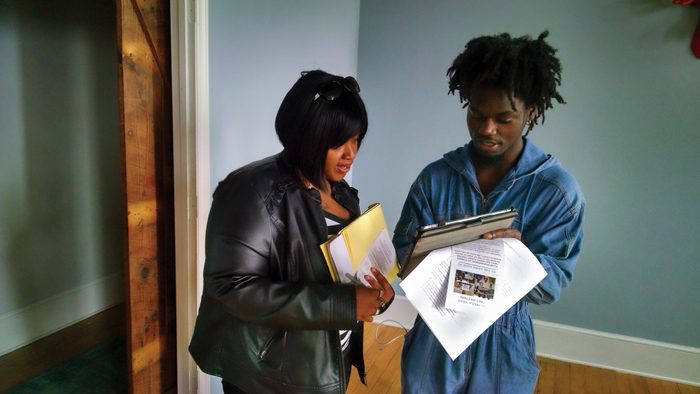
“[Labor leaders] have to … explain the construction of race and capitalism,” says Bill Fletcher Jr., executive editor of The Global African Worker and former AFL-CIO staffer. “The absence of that, and the reliance on so-called diversity programs, at best teaches tolerance but does not get at the particular role that race plays as a division of the working class. They need to embark on massive internal educational efforts.”
Unions should place a higher premium on building solidarity among the working class as a whole, in all of its diversity. One example is the 2020 partnership between the United Electrical Workers (UE) and the Democratic Socialists of America (DSA). The groups formed the Emergency Workplace Organizing Committee to help workers organize on the job in the midst of Covid-19. It’s exactly the kind of alliance the Left and the labor movement should forge, amplifying both groups’ impacts by organizing new workers and engaging existing membership.
These types of alliances demonstrate an attitude of “not me, us” (to quote Sanders’ presidential campaign slogan)— the key to building worker trust and taking on the powerful forces ultimately responsible for the economic inequality so many experience. Reitano believes strongly in his union, but he worries that new hires, who are immigrants, won’t join the union or won’t fight for higher wages, because they are used to lower wage standards. “If the union can educate these people so they understand that we have to stand together, I think it’ll be okay,” he says. In a situation like this, a union political education program could not only engage new members, as Reitano suggests, but also forge solidarity and trust across the old guard/new guard divide.
Currently, however, many unions focus primarily on mobilizing their members to vote, rather than on a more robust political program. In many cases, members don’t have a mechanism to even offer input on the political endorsements of their locals and internationals. Instead, every union shop should have stewards who constantly engage workers in educational programs and struggles on the shop floor. Unions launched campaigns like this in anticipation of the 2018 Janus Supreme Court decision, which allowed public-sector employees in union shops to get the benefits of the union without paying for them. Many unions around the country began proactive campaigns to talk one-on-one with their members about the importance of their union. In the conversations, they stressed the power of collective action and exposed the right-wing forces trying to undermine unions through Janus and other measures. They encouraged members to recommit to being dues-paying members even though they would soon have the ability to become “free riders.”
None of this work will be easy, but unless unions commit to this educational work, Trumpism will continue to grow and the possibility of achieving policy that can actually help working people will diminish. (Left unchecked, Trumpism also could drive an increasingly violent alt-Right.) The Left must support unions in this work by engaging in partnerships (like the DSA/UE partnership) and encouraging workers to organize and unionize.
The Democratic Party, for its part, must prove itself worthy of the union vote. Right now, tens of millions of workers (both union and nonunion) are suffering through unemployment, housing insecurity, hunger and a lack of healthcare in a devastating pandemic. The Democratic Party leadership has barely lifted a finger to put up a real fight to win relief that is desperately needed by so many. They could take example from Sen. Sanders, who has voiced his opposition to the most recent proposed “compromise” stimulus bill. While millions suffer through the coronavirus pandemic with woefully inadequate federal support, Democratic Party leadership has refused to go big, choosing to ignore the progressive Dems’ early push for monthly cash payments and expanded Medicare. Without these steps, the Democrats should not expect working people to vote for them without question.
Without countermeasures from unions and Democrats alike, Republicans will continue to turn the union vote. A 2020 Delaware Senate race between Republican challenger Lauren Witzke and Democratic incumbent Sen. Christopher Coons offers a glimpse of what’s to come. Though she lost (with 38% of the vote), Witzke ran on an “America First” platform including support for unions and collective bargaining, opposition to immigration (on the basis that migrant workers worsen conditions of all workers), and an anti-abortion stance.
While Trump’s racism likely provoked many white professionals to vote against him in 2020, it did not deter a growing group of people of color — and what’s even more alarming than a whites-only right-wing movement is a multiracial one. To counter the appeal of Trumpism, we need to build a multiracial, working-class labor movement that can arm workers with solidarity and a renewed commitment to struggle for the world we deserve.


